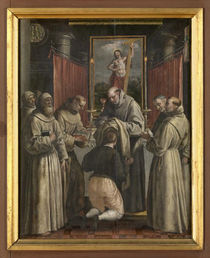The Catholic Defender: Saint Augustine of Canterbury
- Donald Hartley

- May 27
- 3 min read
Deepertruth with special permission and aid with Franiciscan Media, a great team for the Lord

Saint Augustine of Canterbury, also called Austin, (born Rome? —died May 26, 604/605, Canterbury, Kent, England; feast day in England and Wales May 26, elsewhere May 28), first archbishop of Canterbury and the apostle to England, who founded the Christian church in southern England.
He is the Patron Saint of England and while he was told to destroy pagan sites and rituals, he instead used them to help convert people to Christianity, using those same pagan sites and symbols to become Christian ones.
In the year 596, some 40 monks set out from Rome to evangelize the Anglo-Saxons in England. Leading the group was Augustine, the prior of their monastery. Hardly had he and his men reached Gaul when they heard stories of the ferocity of the Anglo-Saxons and of the treacherous waters of the English Channel. Augustine returned to Rome and to Gregory the Great—the pope who had sent them—only to be assured by him that their fears were groundless.
Augustine set out again. This time the group crossed the English Channel and landed in the territory of Kent, ruled by King Ethelbert, a pagan married to a Christian, Bertha. Ethelbert received them kindly, set up a residence for them in Canterbury and within the year, on Pentecost Sunday 597, was himself baptized.
After being consecrated a bishop in France, Augustine returned to Canterbury, where he founded his see. He constructed a church and monastery near where the present cathedral, begun in 1070, now stands. As the faith spread, additional sees were established at London and Rochester.

Work was sometimes slow and Augustine did not always meet with success.
Attempts to reconcile the Anglo-Saxon Christians with the original Briton Christians—who had been driven into western England by Anglo-Saxon invaders—ended in dismal failure. Augustine failed to convince the Britons to give up certain Celtic customs at variance with Rome and to forget their bitterness, helping him evangelize their Anglo-Saxon conquerors.
Laboring patiently, Augustine wisely heeded the missionary principles—quite enlightened for the times—suggested by Pope Gregory: purify rather than destroy pagan temples and customs; let pagan rites and festivals be transformed into Christian feasts; retain local customs as far as possible. The limited success Augustine achieved in England before his death in 605, a short eight years after his arrival, would eventually bear fruit long after in the conversion of England. Augustine of Canterbury can truly be called the “Apostle of England.”
Augustine of Canterbury comes across today as a very human saint, one who could suffer like many of us from a failure of nerve. For example, his first venture to England ended in a big U-turn back to Rome. He made mistakes and met failure in his peacemaking attempts with the Briton Christians.
The Gregorian mission or Augustinian mission was a Christian mission sent by Pope Gregory the Great in 596 to convert Britain's Anglo-Saxons. The mission was headed by Augustine of Canterbury. By the time of the death of the last missionary in 653, the mission had established Christianity in southern Britain.
He often wrote to Rome for decisions on matters he could have decided on his own had he been more self-assured. He even received mild warnings against pride from Pope Gregory, who cautioned him to “fear lest, amidst the wonders that are done, the weak mind be puffed up by self-esteem.” Augustine’s perseverance amidst obstacles and only partial success teaches today’s apostles and pioneers to struggle on despite frustrations and be satisfied with gradual advances.





















Comments